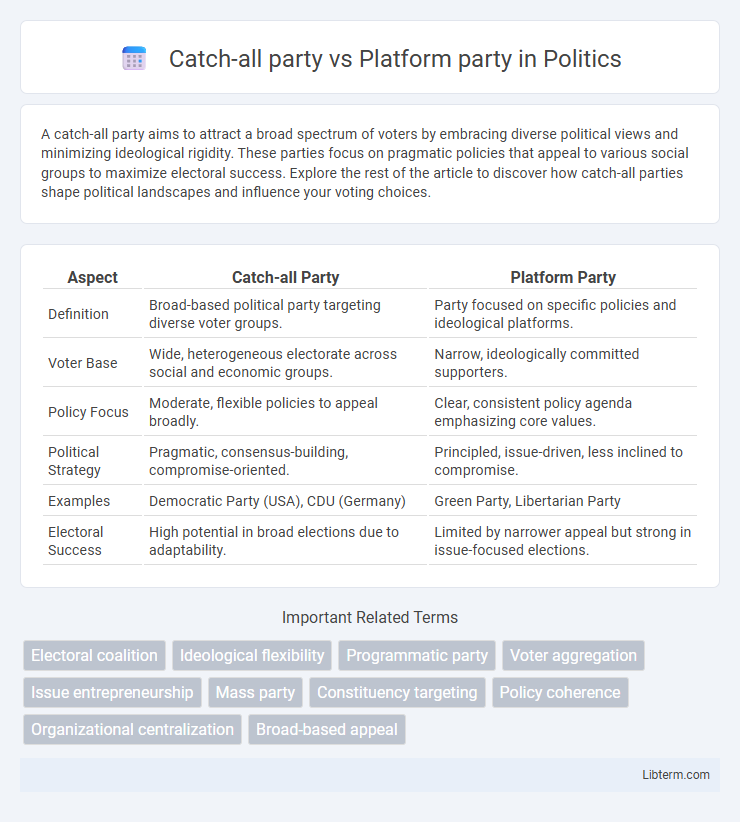A catch-all party aims to attract a broad spectrum of voters by embracing diverse political views and minimizing ideological rigidity. These parties focus on pragmatic policies that appeal to various social groups to maximize electoral success. Explore the rest of the article to discover how catch-all parties shape political landscapes and influence your voting choices.
Table of Comparison
| Aspect | Catch-all Party | Platform Party |
|---|---|---|
| Definition | Broad-based political party targeting diverse voter groups. | Party focused on specific policies and ideological platforms. |
| Voter Base | Wide, heterogeneous electorate across social and economic groups. | Narrow, ideologically committed supporters. |
| Policy Focus | Moderate, flexible policies to appeal broadly. | Clear, consistent policy agenda emphasizing core values. |
| Political Strategy | Pragmatic, consensus-building, compromise-oriented. | Principled, issue-driven, less inclined to compromise. |
| Examples | Democratic Party (USA), CDU (Germany) | Green Party, Libertarian Party |
| Electoral Success | High potential in broad elections due to adaptability. | Limited by narrower appeal but strong in issue-focused elections. |
Introduction to Party Types: Catch-All vs Platform
Catch-all parties aim to attract a broad spectrum of voters by adopting moderate and flexible policy positions, maximizing electoral appeal without strict ideological boundaries. Platform parties, in contrast, are defined by a clear, consistent ideology or set of policy goals, fostering strong loyalty among a specific voter base. Understanding these party types is crucial for analyzing political strategies, voter alignment, and legislative behavior in multi-party systems.
Defining Characteristics of Catch-All Parties
Catch-all parties prioritize broad voter appeal by downplaying ideological purity and emphasizing pragmatic policies that attract diverse social groups. They seek electoral success through flexible platforms and leadership willing to adapt to changing political landscapes. This approach contrasts sharply with platform parties, which maintain clear, rigid ideological stances and speak primarily to specific, well-defined constituencies.
Core Principles of Platform Parties
Platform parties emphasize clear ideological coherence and consistent policy positions to maintain voter trust and organizational unity. They prioritize issue-driven agendas, promoting specific values and goals rather than broad electoral appeal. These core principles foster a dedicated supporter base aligned with the party's mission, distinguishing platform parties from catch-all parties that seek wide-ranging voter coalitions.
Historical Evolution of Political Party Models
Catch-all parties emerged in the early 20th century as broad coalitions aiming to attract diverse voter groups by de-emphasizing ideological purity, reflecting the complexities of industrialized societies. Platform parties, gaining prominence later, emphasize clear, coherent policy agendas and ideological consistency to mobilize politically active and issue-oriented electorates. The historical evolution from catch-all to platform party models illustrates a shift from mass appeal strategies toward targeted, programmatic politics aligned with changing voter behaviors and communication technologies.
Voter Base and Support Strategies
Catch-all parties attract a broad voter base by appealing to diverse social groups and minimizing ideological rigidity, focusing on inclusive policies that broaden electoral support. Platform parties target specific constituencies or interest groups with clearly defined policy agendas, emphasizing ideological coherence to mobilize loyal, issue-driven voters. While catch-all parties rely on pragmatic, flexible strategies to maximize votes across demographics, platform parties concentrate on deepening engagement within segmented voter blocs to ensure consistent backing.
Policy Development Approaches
Catch-all parties develop policies by broadening their appeal to diverse voter groups, often blending various ideological positions to maximize electoral support. Platform parties prioritize clearly defined, consistent policy platforms that reflect specific ideological commitments and target core constituencies. The distinct approaches influence policy coherence, with catch-all parties favoring flexibility and adaptability, while platform parties emphasize ideological clarity and programmatic consistency.
Electoral Success and Party Adaptability
Catch-all parties achieve electoral success by appealing to a broad demographic, using flexible policy platforms that adapt to diverse voter interests and socio-economic changes. Platform parties focus on specific ideological principles or issue-based agendas, which can limit their immediate electoral appeal but foster strong, loyal voter bases and clear policy identities. The adaptability of catch-all parties allows them to capitalize on shifting political landscapes, while platform parties maintain consistency and depth in their core values.
Ideological Flexibility vs. Consistency
Catch-all parties prioritize ideological flexibility to attract a broad voter base, often blending diverse policy positions to maximize appeal. Platform parties emphasize ideological consistency, maintaining a clear and coherent set of principles to build a loyal and ideologically committed electorate. The trade-off between adaptability and coherence shapes party strategies and voter alignment in multiparty systems.
Impact on Democratic Representation
Catch-all parties broaden their appeal by encompassing diverse social groups, enhancing democratic representation through inclusivity and responsiveness to a wide voter base. Platform parties concentrate on specific ideologies or interests, offering clearer policy choices but potentially narrowing representation to particular segments of society. This distinction influences democratic dynamics by shaping voter engagement, policy formulation, and the inclusiveness of political discourse.
Global Examples: Catch-All and Platform Parties
Catch-all parties like Germany's CDU and the United States Democratic Party broaden their appeal by encompassing diverse social groups and policy positions, aiming for electoral dominance across multiple demographics. In contrast, platform parties such as the UK's Green Party or Spain's Podemos emphasize a clear, ideologically driven policy agenda targeting specific voter bases concerned with environmental issues or social justice. These global examples highlight catch-all parties' strategy of electoral inclusivity versus platform parties' focus on issue-based representation and ideological coherence.
Catch-all party Infographic

 libterm.com
libterm.com